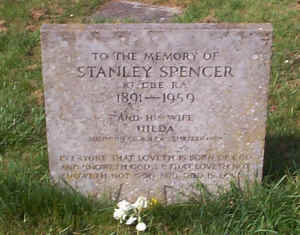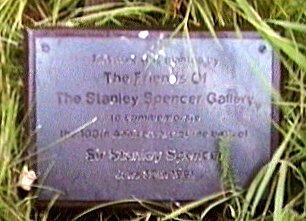Sir Stanley Spencer CBE, RA 1891-1959
The Kings Hall, High Street, Cookham, Berkshire, SL6 9SJ UK Tel: +44 (0)1628-471885 info@stanleyspencer.org.uk
Stanley Spencer was born at Fernlea, Cookham High Street on 30 June 1891, the tenth child of a family of eleven, of whom two died in infancy. His father William was an organist and music teacher. Pupils coming for lessons and his older siblings practicing the piano or the violin created a musical atmosphere in which Stanley flourished. Music was always an important part of his life.
Two of his sisters ran a school in a shed in Fernlea garden and Stanley received his early education at their hands. His reading was based on the Bible, Bunyan and Milton. He attended the parish church as well as his mother's Methodist chapel (now the Spencer Gallery).
Fernlea, especially at mealtimes, was loud with discussion and argument as Stanley's older brothers talked with each other and their parents. Stanley watched, listened and absorbed.
Cookham, prior to the First World War, was a rural community somewhat cut off from the outside world. The village High Street contained not only a working forge, a baker, butcher and chemist but opposite Fernlea, Ovey's Farm, whose cows fascinated Stanley when he sat looking out from the window of his bedroom. His brother Gilbert wrote of the village in summer, with "the excitement of the regatta ending with the fair on Cookham Moor where everyone descended; the gentry and their ladies in their evening clothes joining in with the hoi polloi, Social barriers were down and the mix up was attractive and complete." The young Spencer loved and embraced it all.
His early interest and ability in art was fostered by lessons from a local artist and later by a year at the Maidenhead Technical Institute. In 1908 he went to the Slade School and gained several prizes as well as the nickname "Cookham" because he talked so much about the village and returned home there every night.
Recognition came early, culminating in a knighthood towards the end of his life. Stanley painted over 450 pictures and made hundreds of drawings, many of them set in and around Cookham.
Often, his Cookham paintings were placed in scenes remembered from childhood. Others were painted out-of-doors, the artist, trundling his painting gear along on the old pram he used, was a familiar sight in the village.
In particular he followed his own vision of biblical events taking place in Cookham, and thus created the wonderful series of religious paintings setting the New Testament story in and around the village.
Cookham has greatly altered since Stanley's early days but it is still possible to see many of the settings of his paintings and even the views he recorded so well. We hope the following walk will add to your enjoyment of his work.

Self-portrait (1914)
Oil on canvas 63 x 51 cm
A memorial stone can be seen in Cookham Church, next to a Judas Tree, planted by the Friends of the Stanley Spencer Gallery to commemorate the centenary of his birth.

Spencer Memorial Stone, Cookham Churchyard

Judas Tree, Cookham Churchyard